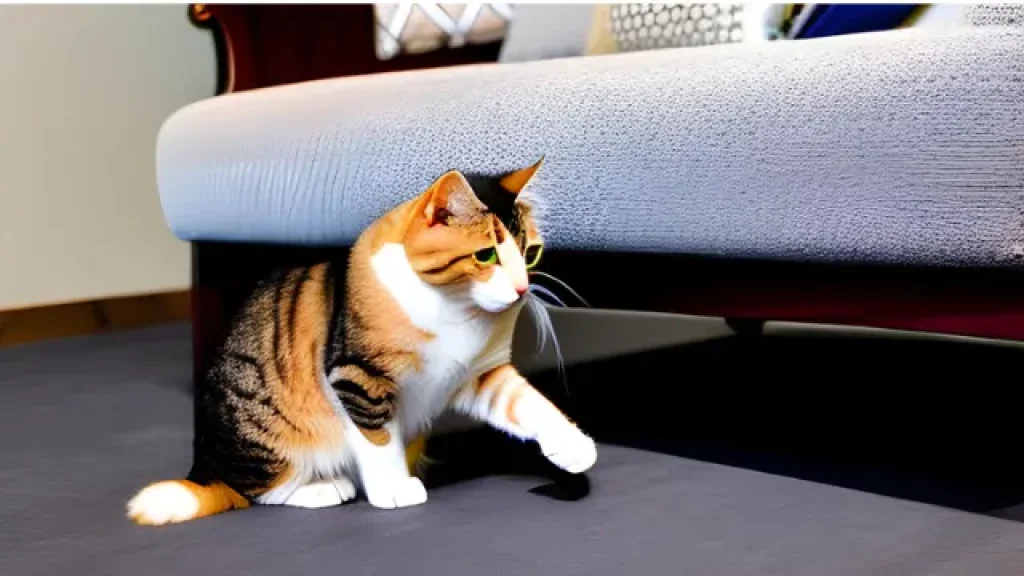Is your feline friend’s territory marking leaving your home in a mess? You might feel embarrassed and annoyed when guests come over, but fear not – you can take steps to prevent this from happening.
We’ll look at what exactly drives cats to mark their territories, as well as explore ways of addressing this issue to ensure both you and your kitty have an enjoyable and stress-free living experience.
Discovering why cats act territorially is key to handling the problem. Cats tend to do it as part of their innate behaviors, communicating with other animals and marking particular scents for security as well as self-expression purposes.
Therefore, once you understand why your cat has been behaving in that way, you can get to work on preventing any more marking.
This could be done by providing additional litter boxes around the house or introducing a special training program designed particularly for fixing territorial behaviors in cats.
With these approaches, you can keep your abode clean while still giving your cat enough freedom to feel safe and secure where they live.
Contents
Definition Of Marking Territory
Marking territory is a behavior common among cats. It’s an instinctive way for them to show their presence by leaving behind either urine or other scents, such as through rubbing the face on objects.
Urine marking is the most prevalent type of marking behavior in cats and can be very difficult to handle if it becomes problematic.
Territory marking involves spraying urine onto surfaces that are visible from a distance, often along walls and doorframes. Cats will also use this method to mark people and items within their environment as belonging to them.
This type of marking behavior can become intimidating and unpleasant when it happens indoors, so understanding why a cat does it and how to stop it is important for maintaining harmony between pet owners and their feline companions.
Causes Of Marking Behavior In Cats

Cats mark their territory for various reasons. Territorial behavior is a natural instinct for cats, especially males who will spray urine around the house to indicate dominance over its environment.
This type of cat marking can be triggered by stress factors such as a new pet in the home or an unfamiliar human presence. It’s also possible that anxiety triggers may cause your cat to mark its territory, including changes to routine and loud noises like thunderstorms.
To help reduce any territorial behavior your cat exhibits due to these causes, it’s important to establish a routine for them with regular playtime and plenty of affection.
Establish A Routine For Your Cat
Studies have shown that an estimated 80% of cats prefer routine and predictability over spontaneity. Establishing a regular schedule for your cat can help reduce or even eliminate their marking behavior.
Providing a daily routine helps to keep your cat in a comfortable environment and decreases anxiety, which is often the underlying cause when cats mark their territory.
When creating a schedule for your cat, make sure it’s realistic and fits into both of your lifestyles.
Start by setting meal times at regular intervals throughout the day and ensure there’s enough food available until the next mealtime.
Feeding meals at consistent times each day will help regulate digestion as well as provide mental stimulation from anticipating meal time.
Additionally, provide adequate playtime with interactive toys such as feather wands or laser pointers to encourage physical activity. Regular exercise not only keeps them healthy but also allows them to express natural predatory behaviors without resorting to destructive scratching or urine marking indoors.
Incorporating plenty of cuddles into their daily routine can further promote bonding between you and your furry friend while providing comfort during stressful situations – like loud noises outside or visitors coming over unexpectedly.
Set aside designated areas inside the house where they are allowed to explore and scratch on acceptable objects, like scratching posts or cardboard boxes filled with crinkly paper balls.
Allowing your cat access to these appropriate outlets for their natural behaviors will discourage them from marking furniture or other items in the home out of stress or boredom.
By establishing a predictable daily routine for your feline companion, you can create an environment free from territorial spraying and improve overall behavioral issues in cats, leading to fewer accidents around the house!
Provide Appropriate Outlets For Your Cat’s Natural Behaviors

It is important to provide your cat with appropriate outlets for their natural behaviors. This includes activities such as scratching, playing, climbing, and exploring.
By providing a safe environment that allows them to express these needs in acceptable ways, you can help reduce the chances of territorial marking around your home.
Here are some tips on how to provide proper outlets for your cat:
- Provide a sturdy scratching post: Scratching posts allow cats an outlet for their instinctual urge to scratch. Make sure the post is tall enough so they can stretch out fully when reaching up to scratch it.
- Schedule regular playtime: Playing helps satisfy cats’ hunting instincts by giving them something fun and interactive to do. Regular playtimes also gives cats much-needed exercise which will release endorphins and make them feel happier overall.
- Offer toys or puzzle feeders: Puzzle feeders or toys give cats something interesting and engaging to focus on while providing mental stimulation. These items can keep cats occupied during times when owners cannot be present.
- Invest in vertical space: Cats love having high places where they can climb, explore, and survey their territories from above safely away from any potential dangers below. Providing shelves, cubbies, and other types of elevated spaces offers more opportunities for enrichment through exploration.
- Consider a window perch: Window perches allow cats access to sunlight and fresh air without being exposed directly outdoors. Watching birds and other animals outside provides additional entertainment value for curious kitties who enjoy observing nature at its finest!
By making sure that all of your cat’s basic needs are met – food, water, shelter – along with providing adequate outlets for their natural behavior patterns, you’ll create an environment where territorial marking is less likely occur within your home
Deterrents And Repellents
The first step to stop a cat from marking its territory is using deterrents and repellents. Cat repellent products are widely available, ranging from pet deterrents to natural remedies.
Pet deterrents such as anti-marking sprays contain scents that cats find unpleasant and may deter them from returning to the same spot. Natural repellents can also be used; for example, citrus peels or coffee grounds have been known to ward off cats due to their strong odors.
Regardless of the type of product used, it should be applied liberally in areas where cats have marked previously.
It’s important to note that many commercial repellent products don’t always work effectively on all cats. Additionally, certain ingredients in some cat repellent products can cause irritation if they come into contact with skin or eyes.
If you’re unsure about which product is right for your situation, consult with a veterinarian who can provide guidance on how best to use these items safely and effectively.
When dealing with a cat marking problem, it’s also important to consider consulting with a veterinarian. This will ensure any underlying medical issues are ruled out before attempting other solutions such as using deterrents and repellents.
With this information in hand, owners can make an informed decision about what course of action works best for their pet’s needs and lifestyle. From there, they can take steps towards resolving the issue at hand.
Consulting With A Veterinarian
If your cat marking behavior has become a serious source of frustration, consulting with a veterinarian may be necessary.
After all, no one knows cats better than those who have dedicated their lives to studying them! Here are the top three reasons why you should visit the vet for help on how to stop your cat from marking its territory:
- Your vet is an expert on animal health and can provide valuable advice specific to your cat’s situation;
- They will be able to identify any medical causes for the behavior that may require treatment or medication;
- A full physical examination will ensure there are no underlying health issues causing your pet distress which could further contribute to its territorial marking.
Visiting the vet doesn’t necessarily mean they’ll be prescribing expensive medicine either – it’s just as likely they’ll suggest modifying your home environment in some way such as providing more litter boxes or calming sprays, changing food brands or offering tips on how best to make use of deterrents and repellents discussed earlier.
Perhaps most importantly though, they will offer guidance on how to manage stressors like changes in routine that could also be affecting your pet’s behavior.
So if you want an action plan tailored specifically to meet the needs of both you and your furry friend then don’t hesitate – book an appointment with a veterinarian today and get started on solving this problem once and for all!
FAQs
Is It Normal For Cats To Mark Their Territory?
Yes, it is normal for cats to mark their territory. It is a natural behavior for cats to communicate with other animals and establish their presence. However, if your cat is marking excessively or in inappropriate areas, it may be a problem that needs to be addressed.
How Can I Tell If My Cat Is Marking Its Territory?
It’s not uncommon for cats to stake their claim through scent marking! If you notice your feline friend rubbing its face or body against walls, furniture and doorframes, or if it sprays urine on vertical surfaces, that’s likely a surefire sign it’s creating a territory all its own.
Are There Any Medical Causes Of Marking Behavior In Cats?
Indeed, urinary tract infections, bladder stones, and other medical disorders can prompt cats to spray urine about the house. Get the advice of a vet to be sure there isn’t a medical explanation.
What Kinds Of Deterrents And Repellents Can I Use To Stop My Cat From Marking Its Territory?
There are several types of deterrents and repellents that can be used to discourage cats from marking their territory. These include pet deterrent sprays, natural remedies such as citrus peels or coffee grounds, and pheromone products that can help calm cats and reduce marking behavior.
How Often Should I Consult My Veterinarian About My Cat’s Marking Behavior?
If your cat’s marking behavior is causing a significant problem or is a recent behavior change, it is recommended to consult with a veterinarian. Additionally, it is important to have regular check-ups with your veterinarian to ensure your cat’s overall health and well-being.
Conclusion
Cats like to mark their territory with scratches and smells, but it can be a problem at home. To stop this behavior, you can do things like put up deterrents and repellents. You should also check if the cat has a medical problem that’s causing them to behave this way.
It might take some time, but if you stay consistent with the methods you choose, you should eventually see improvement.
Finally, don’t forget that prevention is key! Consult with your veterinarian regularly about any health issues or behavioral problems so you can catch them early on before they become too difficult to manage. With the help of an experienced professional, you’ll be able to get your kitty back on track in no time at all!


